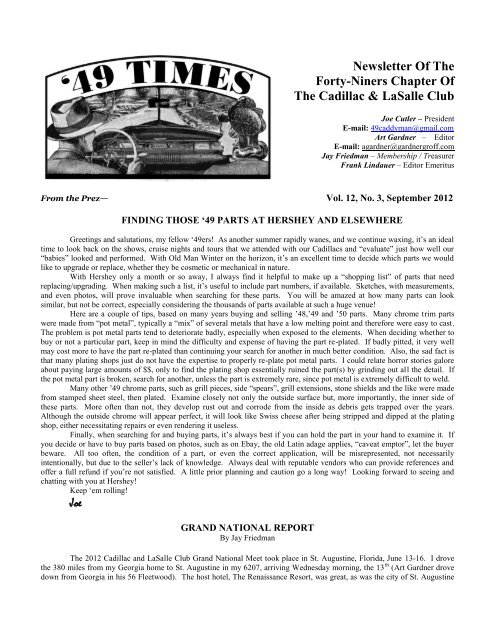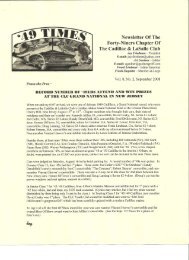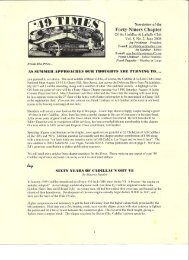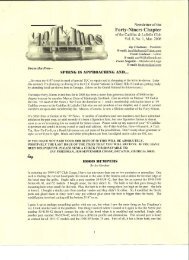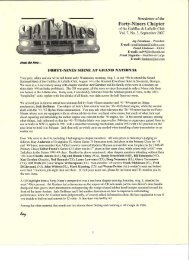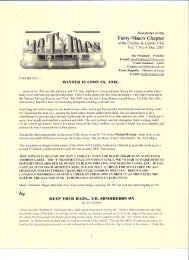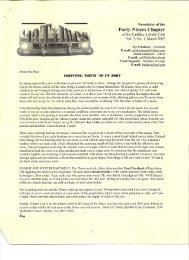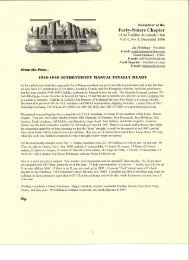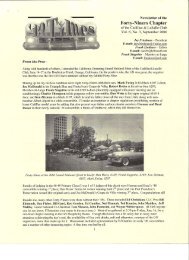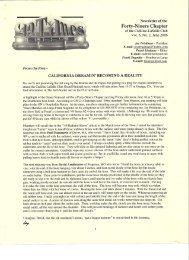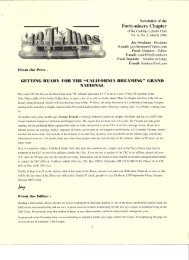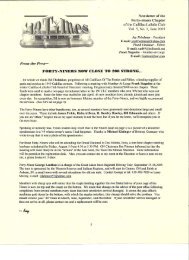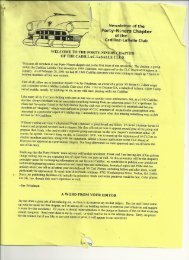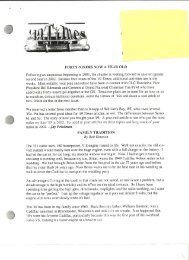You also want an ePaper? Increase the reach of your titles
YUMPU automatically turns print PDFs into web optimized ePapers that Google loves.
Newsletter Of The<br />
Forty-Niners Chapter Of<br />
The Cadillac & LaSalle Club<br />
Joe Cutler – President<br />
E-mail: 49caddyman@gmail.com<br />
Art Gardner – Editor<br />
E-mail: agardner@gardnergroff.com<br />
Jay Friedman – Membership / Treasurer<br />
Frank Lindauer – Editor Emeritus<br />
From the Prez— Vol. 12, No. 3, <strong>September</strong> <strong>2012</strong><br />
FINDING THOSE ‘49 PARTS AT HERSHEY AND ELSEWHERE<br />
Greetings and salutations, my fellow ‗49ers! As another summer rapidly wanes, and we continue waxing, it‘s an ideal<br />
time to look back on the shows, cruise nights and tours that we attended with our Cadillacs and ―evaluate‖ just how well our<br />
―babies‖ looked and performed. With Old Man Winter on the horizon, it‘s an excellent time to decide which parts we would<br />
like to upgrade or replace, whether they be cosmetic or mechanical in nature.<br />
With Hershey only a month or so away, I always find it helpful to make up a ―shopping list‖ of parts that need<br />
replacing/upgrading. When making such a list, it‘s useful to include part numbers, if available. Sketches, with measurements,<br />
and even photos, will prove invaluable when searching for these parts. You will be amazed at how many parts can look<br />
similar, but not be correct, especially considering the thousands of parts available at such a huge venue!<br />
Here are a couple of tips, based on many years buying and selling ‘48,‘49 and ‘50 parts. Many chrome trim parts<br />
were made from ―pot metal‖, typically a ―mix‖ of several metals that have a low melting point and therefore were easy to cast.<br />
The problem is pot metal parts tend to deteriorate badly, especially when exposed to the elements. When deciding whether to<br />
buy or not a particular part, keep in mind the difficulty and expense of having the part re-plated. If badly pitted, it very well<br />
may cost more to have the part re-plated than continuing your search for another in much better condition. Also, the sad fact is<br />
that many plating shops just do not have the expertise to properly re-plate pot metal parts. I could relate horror stories galore<br />
about paying large amounts of $$, only to find the plating shop essentially ruined the part(s) by grinding out all the detail. If<br />
the pot metal part is broken, search for another, unless the part is extremely rare, since pot metal is extremely difficult to weld.<br />
Many other ‘49 chrome parts, such as grill pieces, side ―spears‖, grill extensions, stone shields and the like were made<br />
from stamped sheet steel, then plated. Examine closely not only the outside surface but, more importantly, the inner side of<br />
these parts. More often than not, they develop rust out and corrode from the inside as debris gets trapped over the years.<br />
Although the outside chrome will appear perfect, it will look like Swiss cheese after being stripped and dipped at the plating<br />
shop, either necessitating repairs or even rendering it useless.<br />
Finally, when searching for and buying parts, it‘s always best if you can hold the part in your hand to examine it. If<br />
you decide or have to buy parts based on photos, such as on Ebay, the old Latin adage applies, ―caveat emptor‖, let the buyer<br />
beware. All too often, the condition of a part, or even the correct application, will be misrepresented, not necessarily<br />
intentionally, but due to the seller‘s lack of knowledge. Always deal with reputable vendors who can provide references and<br />
offer a full refund if you‘re not satisfied. A little prior planning and caution go a long way! Looking forward to seeing and<br />
chatting with you at Hershey!<br />
Keep ‗em rolling!<br />
Joe<br />
GRAND NATIONAL REPORT<br />
By Jay Friedman<br />
The <strong>2012</strong> Cadillac and LaSalle Club Grand National Meet took place in St. Augustine, Florida, June 13-16. I drove<br />
the 380 miles from my Georgia home to St. Augustine in my 6207, arriving Wednesday morning, the 13 th (Art Gardner drove<br />
down from Georgia in his 56 Fleetwood). The host hotel, The Renaissance Resort, was great, as was the city of St. Augustine
which has a neat waterfront area with lots of good restaurants. There were a number of ‗49ers attending besides me, including<br />
Ray Anderson, Sig Chrey, Frank Dickinson, Bill Edmunds, Art Gardner, John Giltinan, Ned Hannah and John Washburn. No<br />
doubt, there were others, too. A few of us gathered one evening, some with drinks in hand, as per the photo below. Left to<br />
right: ‗49er John Washburn, non-member Matern Harmsel, CLC Director of Technical Services Bill Anderson, ‘49 Times<br />
Editor Art Gardner, ‗49er Sig Chrey and your author.<br />
On the other hand, only 3 of us brought ‗49s to the GN: Ray Anderson‘s Series 75 limousine, John Giltinan‘s Series 62 4-door<br />
and my aforementioned Series 61 Club Coupe.<br />
The photo below is of Ray‘s limo, which won a first prize in Primary Class 12 for all ‗42-‗47s and ‘48-‗49 Series 75.<br />
RAY ANDERSON’S SERIES 75<br />
The next photo is of John‘s gorgeous 6269 on the show field. It won a first prize in Primary Class 13 for ‗48s and ‗49s.
JOHN GILTINAN’S SERIES 62 4-DOOR SEDAN<br />
The photo below shows the judges busily finding fault with my 6107, while I stand by vowing to correct everything when I get<br />
home. My car did win a third prize in Senior Wreath Class SW4 for 1939-49 Cadillacs.<br />
A highlight of the GN from the ‗49er point-of-view was a chapter meeting Saturday, the 16 th , at which 6 members and several<br />
guests were present. At the meeting John Washburn gave a talk on rebuilding distributors, Art Gardner spoke about repairing<br />
door latches and Ray Anderson told us the story of his limousine, which he has owned since 1960. A fine time was had by all.<br />
THOSE 6 VOLT BLUES<br />
By Joe Cutler<br />
Scenario: You‘ve just pulled into the local Cruise Night with your freshly-polished and detailed pride and joy. She's "lookin'<br />
good," and a crowd of admirers quickly assemble to get a closer look and hear all about your gem on wheels. You proudly field<br />
onlookers‘ questions and, of course, someone wants to "hear her run". Having already exclaimed that "she purrs like a kitten," you<br />
slide behind the wheel and turn the key, expecting the engine to instantly spring to life. Instead, you‘re greeted with a sickening,
groaning noise as the engine laboriously turns over and the battery goes flatter than the lens on the Hubbel Space Telescope. The<br />
crowd quickly dissipates and walks away shaking their heads, leaving you sitting there quite embarrassed, wondering what happened!<br />
The following may seem elementary, and many of you may already know all about it, but I never cease to be amazed at the<br />
number of phone calls I receive from owners of older cars with 6 volt systems who are experiencing similar starting problems and are<br />
stymied as to the solution to their woes. American cars and trucks didn't switch over to 12 Volt systems until the mid-1950's. Far too<br />
many owners of vehicles with the original 6 volt systems who experience starting problems in desperation convert, or attempt to<br />
convert, their vehicle to 12 Volts using special batteries or 6/12 Volt "converter" units, some resembling Rube Goldberg inventions,<br />
with mixed results, rather than getting to the heart of the problem! My contention is, and always has been, "If they started back then,<br />
they should start now!" However, that's true only if everything related to the starting system is in top condition.<br />
I experienced this problem firsthand when I recently bought a 1949 Cadillac limousine. The previous owner complained that<br />
the car would never start once the engine warmed up, so he had some enterprising "mechanic" install a 6/12 Volt "converter" that<br />
would supposedly "fix the problem". I guess it may have worked for awhile – until the owner pulled the car into his garage one day<br />
and noticed smoke billowing from the engine compartment. Yep, he had a wiring fire! After emptying a fire extinguisher on the<br />
melted mess, he became disgusted with the car and decided to sell it.<br />
Once I got the car home I went to work. I discovered the converter mounted on the inner fender well with a myriad of<br />
narrow gauge wires going everywhere, most of which had fused together during the fire. I first eliminated this converter and<br />
deposited it where it belonged – in the scrap metal pile. I then cut back and disposed of all non-original wiring and proceeded to<br />
solder in new, proper gauge wires. I removed the starter and brought it to a local re-builder, who informed me the armature was junk.<br />
I had a few extra parts and a new solenoid, so he was able to put together a starter, which now functioned as it should.<br />
Then I found that someone had installed a light gauge positive battery cable. I had a new one custom-made at R.I. Wiring<br />
Service in the heaviest gauge they offered – ONE GAUGE. Finally, I removed the negative ground strap and cleaned it, including all<br />
points at which it was connected – starter bolt, frame, and the battery terminal itself. I then cleaned the end of the starter where it bolts<br />
to the bell-housing, and the bell-housing itself, and installed the rebuilt starter. I bought a heavy-duty 6 volt battery with a minimum<br />
of 650 cold cranking amps and installed it. VOILA! The engine now "whips over" and starts like new, no matter how hot the engine!<br />
In summary, here are some things to check/remedy if you experience hard starting on your 6 Volt vehicle:<br />
1. Condition of the engine itself. The engine must have at least decent compression. Check the condition of electrical components<br />
like ignition points, condenser, rotor, distributor cap, spark plug wires, spark plugs, engine timing, condition of the carburetor,<br />
and proper carburetor adjustments.<br />
2. Check the condition of the starter motor. Worn brushes, armature or solenoid, and worn end bushings can all cause problems.<br />
3. CLEAN all electrical connections, including battery terminals, battery posts, and all points where battery cables attach to the<br />
starter and frame. Don‘t forget to clean any rust and/or paint from the starter and the bellhousing where the starter bolts!<br />
4. Buy the heaviest-duty battery available. A minimum of 650 cold cranking amps is recommended.<br />
5. Install the heaviest gauge positive battery cable possible, such as #1 gauge as previously outlined. Be sure to install a cable of the<br />
PROPER LENGTH! Too long a cable could result in current/voltage "drop", which will adversely affect the starting system.<br />
If all of the above is observed, your pride and joy should spring to life upon demand each and every time!<br />
FOG/PARKING LIGHT HOUSING TO FENDER GASKET<br />
Discussion Started By Bill Bickle<br />
When our ‗48s and ‗49s were new there was a gasket between the perimeter of the front of the fog light or parking<br />
light assembly and the back of the opening in the fender where it mounts. This was the subject of a lively discussion on the<br />
CLC online Forum a couple of months ago. It seems the gaskets frequently become so worn with time that they not only<br />
disappear but have been largely lost to our collective memory. A well known Cadillac parts vendor even stated that he was<br />
unaware of the gasket. Bill Bickle wrote, ―No one beyond a select few chapter members appear to know about this anomaly.<br />
Jeff Maltby appears to have a set but he is the only one.‖<br />
The Cadillac Master Parts List, the ultimate arbiter, shows that the gasket indeed exists. It‘s the ―Fog Lamp Opening<br />
Rubber Gasket, group number 10.0085, part number 145 4917 for ‗49s and 145 2989 for ‗48s. Prez Joe Cutler writes that ―I've<br />
scraped off melted remnants of said gaskets from original fog light housings during my restorations. The gaskets prevent junk<br />
thrown up by the front wheels from ‗seeping‘ through the gap between the housings and inside of the fender. I also believe<br />
they act as a ‗cushion‘ to help eliminate squeaks and other objectionable noises that could otherwise occur.‖ Since the gaskets<br />
are not being reproduced, Joe adds that ―What I use, that is inexpensive and effective, is a simple roll of foam weather-strip<br />
with one self-adhesive side, such as used around door openings in a home. I buy the largest size possible--I think it's ¾ x ¾ of<br />
an inch (19 mm.). I've found it works quite well and no one will see it anyway once the fog light units are re-installed.‖
1948 FOG LAMP 1949 FOG LAMP<br />
Editor Art Gardner writes that to make this gasket ―I used a flat, rectangular roll of foam rubber that I bought at Home<br />
Depot. I think it was about ½ an inch (12 mm.) thick by about ¾ of an inch wide. I may have doubled it on the ends of the<br />
housing, but I forget exactly. It worked pretty well. The seal is skinnier in the middle and fatter on the ends. I tried to find the<br />
real stuff, but no one makes or sells it. I bought wrong items twice. I also talked to Steele Rubber about it and never could<br />
understand why they wouldn't make it. I guess they are hoping to develop some pent up demand and then make one big batch,<br />
so I finally gave up. Steele once told me that to make the seal, they needed an original to use as a pattern, but all of the<br />
originals I have seen have been disintegrated garbage and were not usable as a pattern. But Jeff Maltby's gaskets look good<br />
enough to be used as a pattern, so maybe he could lend them one to allow them to make these parts for the first time.‖ Art<br />
reports that Steele supposedly is working on making this item using Jeff‘s good set of gaskets as a pattern. Let‘s hope so!<br />
JOE & DIANE LANE, AND DAUGHTERS, OF MILTON, MASSACHUSETTS<br />
NEW CHAPTER MEMBERS AND NEW OWNERS OF THE BARONESS, EX- JOE CUTLER<br />
REMOVING AND REPLACING A ’49 CADILLAC CYLINDER HEAD<br />
By Jay Friedman<br />
Some months ago the cylinder heads of my ‗49‘s motor needed rebuilding, so I removed them and took them to a<br />
machine shop for repair. Taking off the cylinder heads with the motor in the car is not particularly difficult technically and the
only special tool needed is a torque wrench. On the other hand, there are lots of parts to remove (and later re-install) and the<br />
heads are heavy, weighing more than 50 pounds each, so it can be a 2-person job.<br />
The first task is to completely drain the coolant from the radiator and engine block. To do this, first raise the front of<br />
the car on jack stands. The motor has 2 small drain outlets on either side of the middle of the block, just above the oil pan.<br />
The Cadillac factory closed these off with small pipe plugs, which when removed usually results in the coolant flowing out in<br />
the wrong direction and making a mess. I replaced mine with drain cocks identical with the radiator drain cock, so I can put a<br />
rubber hose on each to direct the flow into buckets. While you are under the car, remove the oil dipstick tube and dipstick.<br />
Back on top, after lowering the car, unfasten one of the battery cables and remove the windshield washer bottle and bracket.<br />
Next, remove the rubber fuel line. Then, drain the oil filter if you have one. Now, disconnect the upper and lower oil<br />
filter tubes at the oil filter end, leaving the tubes attached to the motor, and remove the oil filter. Unfasten the 4 bolts holding<br />
the thermostat housing to the water pump. Loosen the upper radiator hose clamp, turn the upper hose on the radiator outlet one<br />
quarter to one half turn to free the thermostat housing and remove the hose and the thermostat housing as a unit. Remove the<br />
fan belt, the fan and the generator along with its adjusting strap. Remove the lower radiator hose. Now the radiator and water<br />
pump can be unbolted and removed. I find it‘s easier for 2 people to lift the radiator.<br />
The next task is to remove the intake manifold. First, remove the air cleaner. Next, remove the accelerator linkage<br />
spring and unhook the accelerator linkage from the carburetor. Fold the accelerator linkage back against the firewall and hook<br />
it under one of the hoses or wires on the firewall. Disconnect the Hydramatic ―kickdown‖ rod at the carburetor and<br />
transmission ends and remove it from the car. Disconnect the vacuum advance tube at both ends and remove it. Disconnect<br />
the manifold vacuum tube at the fuel pump end. Disconnect the automatic choke tube at both ends and remove it from the car.<br />
Disconnect all wires from the coil (back-up light wire, coil power wire, coil to distributor primary and secondary<br />
wires) and tie them back to a hose or wire at the firewall. Disconnect the fuel pump to carburetor tube at the carburetor end.<br />
Tilt it up to a sufficient angle on the fuel pump that fuel doesn‘t flow out but leave it in place. Loosen and remove the four<br />
bolts and four nuts with their washers that hold the intake manifold to the cylinder heads. Now the manifold can be removed<br />
with the manifold-to-fuel pump vacuum tube, carburetor and coil still attached. One person can lift it, it may be easier if you<br />
are two people.<br />
Now the heads are almost ready to remove. Starting with the driver‘s side head, unthread the spark plug cables from<br />
the loops on the valve cover on a late motor, or unfasten the spark plug wire conduits on an early motor, and tie them up to a<br />
hose or wire on the firewall. Remove the valve cover and set it aside. Remove the water hose that runs between the head and<br />
the defroster assembly. (I find it easiest to cut this hose, as it is hard to get a good grip to pull it off.) Unscrew the cylinder<br />
head ground strap at the firewall end. Now, unscrew the cylinder head bolts. Since the rocker arm assembly is full of oil,<br />
before removing it get a pan or other receptacle longer than the rocker arm assembly. With the pan ready to catch any oil, lift<br />
off the rocker arm assembly with its four bolts and set aside on the pan.<br />
Remove the push rods. You must re-install the push rods with the same end toward the rocker arms and, preferably,<br />
in the same valve lifter. Note the shape of the push rod at each end. Punch holes in a piece of card board, number the holes<br />
with a pen or pencil and, to keep them organized, insert the push rods into the holes in numerical order with their top ends up.<br />
Remove the 6 exhaust manifold bolts. Leave the exhaust manifold in place, since the crossover pipe is very rigid and will<br />
easily support the exhaust manifold after the head is removed.<br />
Getting the passenger‘s side head ready is similar. Unscrew the nut holding the wire to the water temperature sending<br />
unit. The voltage regulator can be left in place, but you risk banging the head into it. I usually unscrew the voltage regulator<br />
mounting screws and lay the regulator with its wires still attached on the nearby shock absorber with a rag underneath it. Deal<br />
with everything else in the same manner as the driver‘s side head. The crossover pipe and exhaust pipe are very rigid and will<br />
support the exhaust manifold easily after the head is removed.<br />
Before lifting off the heads, it‘s a good idea to put some towels or other protection on the fenders and on the baffle in<br />
front of the radiator. If a head is stuck, tap it with a hard rubber hammer to dislodge it. You can grab the head by the water<br />
pump hole at one end and either the heater pipe, temp gauge sending unit or the ground strap at the other end. An assistant‘s<br />
help can be useful at this point. Alternatively, you could use a ―cylinder head lifting tool‖, which are T-shaped tools that screw<br />
into the spark plug holes. You then pick up the head by the ―T‖ crossbar. I have two I‘ll lend to anyone who needs them. On<br />
the bench, remove the driver‘s side head heater hose pipe, the passenger‘s side head temperature gauge sending unit, both<br />
ground straps and the small pipe plugs at the rear of the passenger‘s head and the front of the driver‘s head.<br />
Have your heads rebuilt in a reputable shop. It‘s a good idea to have the re-builder install hardened steel exhaust<br />
valve seats so the engine can better cope with unleaded fuel.<br />
Re-install everything in reverse order. Head gaskets will say ―TOP‖ on one side, so lay new ones thusly on the block<br />
with the guide studs engaged. Carefully lay the heads on the block, engaging the guide studs underneath it and ensuring that<br />
the gasket is not folded back or kinked. Torque the head bolts to 65-70 foot pounds in the order shown on the next page:
Re-install everything else using new gaskets. Be sure to put a bit of oil at both ends of the push rods. To make their<br />
installation easier, lightly cement new water pump gaskets to the front of the pump after scraping off the old gaskets. To<br />
facilitate exhaust manifold gasket installation, use a pry bar or large screwdriver to slightly pry the manifolds away from the<br />
head. Don‘t install the intake manifold until all cylinder head bolts are torqued. Intake and exhaust manifold bolts and water<br />
pump bolts should be torqued to 25-30 foot-pounds.<br />
ANOTHER 6269<br />
By Joe Cutler<br />
[Ed. Note: Following the sale of his gorgeous 4-door, the Baroness, Prez Joe Cutler has been continuing the<br />
resurrection of his newly acquired 37,000 mile, original 6269 sedan from Colorado, The Empress.]<br />
Joe writes: ―We wet sanded the recently re-painted hood, firewall and dashboard with 2000 grit and buffed out the<br />
pieces. I masked off the hood & freshened up the under-carriage with new undercoating. My glass man swung by and<br />
installed the brand-new driver's side windshield, and my auto body man helped me re-install the hood. Lookin' great!<br />
I also re-wired the back-up lights--they work perfectly—and eliminated the electric fuel pump the previous owner<br />
installed so the car will run off the original rebuilt mechanical pump.<br />
Now for the bad news. (I thought things were going too well so far!) While running the engine and getting ready to<br />
time it, I (thank God) happened to notice the reflection of light off something shiny on the garage floor. I looked underneath<br />
the car and discovered, much to my surprise and horror, a massive puddle of fresh oil under the rear parts of the engine! I<br />
thought the rear main seal let go, as over a quart of oil was pumped out onto the floor in a matter of minutes. Luckily it turned<br />
out to only be a loose fitting where the oil pressure gauge tube screws into the upper rear of the motor, which was a great relief.<br />
Just another obstacle to overcome, and there's been loads of those this year with all the cars! The car now runs like a Swiss<br />
watch! Here's a recent photo.<br />
JOE CUTLER’S NEW SERIES 62 4-DOOR, THE EMPRESS


